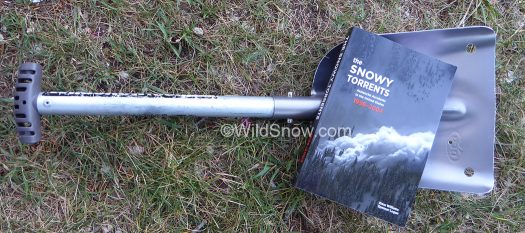Is gleaning the details and opinions regarding serious (often fatal) avalanche accidents worth your time? For years here at WildSnow we’ve taken the point of view that yes, the more details the better. Details save lives. Thusly, despite criticism and sometimes even hate mail, we’ve taken the time to analyze and publish our take on selected accidents.
My model for this has always been the “Snowy Torrents” series of avalanche accident compendiums; four volumes published since the first 1967 edition — a half century ago! After a gap of 20 years since the fourth edition, this new 5th “Torrents” is a modernized version with excellent writing, editing, and design. Yes, details are shared. Names are named. Fact based opinions are presented in a “Comments” section for each accident report.
To be fair, we have total sympathy for anyone involved in any mountain recreation accident, be it snow or otherwise. Thus, my writing about this has often been agonal. Sometimes I feel like throwing my hands up and quitting. It doesn’t help when I think back on the long list of friends and acquaintances who’ve perished. Often, those tragedies were unnecessary and could have been easily prevented or at least mitigated with a few simple actions.
That’s where “Snowy Torrents” comes into play. While I know the authors (Knox Williams and Spencer Logan) and am certain they feel as uncomfortable sharing details of personal tragedies as much as any other empathetic person would. They succinctly address their motivations in the book’s front material. “…The intent is to teach by example, both good and bad” they write, “as you read these personal stories, one fact will become apparent: people repeat the same mistakes over and over. If we…can help break this cycle, we can save lives…”
In my opinion, the recent ramping up of avalanche education — including the sharing of actual accident scenarios in the media and during avalanche safety classes — has indeed been breaking the cycle. Simply witness what’s happened here in Colorado. We have now had two winters with ZERO backcountry skier avalanche deaths. That is simply amazing and strangely under reported, perhaps because humble educators are reluctant to take credit. Yes, we’ve had some unusually good snowpacks over the past few winters. Yet we’ve had plenty of danger, close calls, and a number of live saves. But the fact remains. For decades now we’ve had double digits expansion in folks skiing backcountry and sidecountry avalanche terrain, with a concurrent REDUCTION in fatalities. Something is going well. Let’s keep it up.
To that end, your summer reading assignment is clear. Grab a copy of “Snowy Torrents 1996-2004” and read every word. Identify common threads that result in fatal accidents. Example: You can use handy charts in the appendices to identify common mistakes that if avoided could have easily mitigated or possibly prevented the accidents. Two of those are obvious, the first being violations of the “expose one person at a time to hazard” axiom, and the second being “never ever entirely split up your group, remain in voice and visual communication a much as is safely possible.”
When you read, you’ll get a sense for a few other common accident “trigger” situations or events, such as that of simply ignoring or being ignorant of prime avalanche terrain on a micro scale. In other words, avoiding trigger zones and steeper sections of otherwise somewhat safer terrain. Your read will reveal other items to be aware of. This leads me to my only firm criticism of the book. I’m guessing someone at publisher American Avalanche Association has much more extensive spreadsheets, such that can be sorted according to the root “causes” that are charted in the book’s “Accident Index.” For example, a graphic that illustrated how many accidents involved “More than one person on slope” as opposed to “Lack of training” would be useful. You can get a sense of this from the included index chart, but doing so is tedious as the chart covers twelve pages.
More charting would have indeed added quite a few pages and subsequent cost — when publishing on paper you do have to call it quits at some point. Perhaps my point is moot. When you do your summer reading assignment and absorb every word of these reports covering 220 tragic deaths in the mountains we love, I think you’ll get a pretty good sense of what you can do better. I did.
I’ll end with a high note. Hundreds of thousands of backcountry ski days are enjoyed _without_ accidents, showing it’s possible to have a full life of mountain recreation without experiencing the horrors covered in this book. How is that done? Anyone will acknowledge that something like “luck” or “fate” plays a part. Yet in my opinion that’s a minor factor.
Fact is, if you fanatically adhere to certain principles of behavior in avalanche terrain your chance of getting “slid” is slim to none.
Where can you learn about such behavior? Start with Tremper’s Stone Tablets of Avalanche Safety, then read Snowy Torrents and see which accidents could have been prevented. If you’re new to this game, I think you’ll be surprised. If you’re an old hand, you’ll probably be nodding your head — yet at the same time you’ll be thinking about how you could do better.
“Snowy Torrents 1996-2004 is 350 pages, including four appendices. Available from publisher American Avalanche Association and presumably from your favorite world domination etailer.
WildSnow.com publisher emeritus and founder Lou (Louis Dawson) has a 50+ years career in climbing, backcountry skiing and ski mountaineering. He was the first person in history to ski down all 54 Colorado 14,000-foot peaks, has authored numerous books about about backcountry skiing, and has skied from the summit of Denali in Alaska, North America’s highest mountain.

